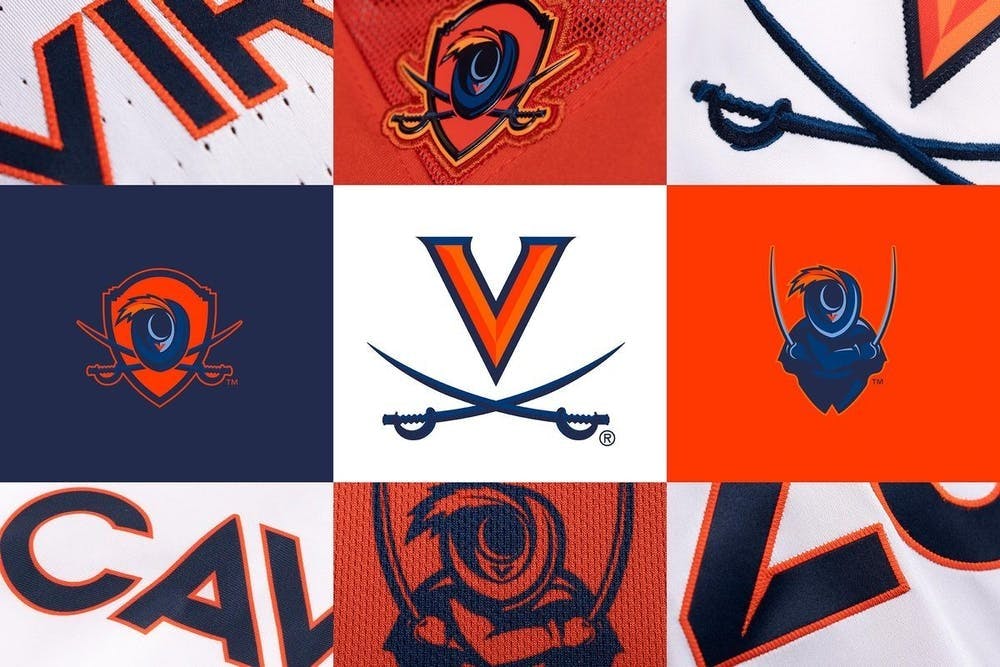In the midst of numerous and vocal calls for University administration to mandate CR/NC grading for the entire undergraduate student body and the ongoing uncertainty regarding the fall semester, the University unveiled several new logos for its athletics program. The response to the new logos has been less than positive. “When I first glanced at it, I thought it was a cockroach,” said one Albemarle County resident. Despite any aesthetic preferences for the University’s athletic logos, one aspect of the new designs has not gone unnoticed by the student body — the grip of the updated sabres was designed to "mimic the serpentine walls" that outline many of the pavilion gardens, according to Virginia Athletics.
Clearly, the inclusion of the serpentine walls in the logo was intended to spotlight the University's rich architectural history. U.Va. director of athletics Carla Williams even said “It’s exciting and it maintains UVA’s sense of history and a strong connection to the past. It pays homage to our tradition.” However, the serpentine walls had a very specific purpose in the darker parts of the University’s history, as they were originally constructed at a height to shield the sight of the enslaved workers from the view of students and professors. It is crucially important to recognize the racist history of the University's Grounds. Nevertheless, incorporating problematic histories into the emblems intended to represent our athletic teams completely disregards the complexities of this past. While there should be a greater awareness of the original purpose of the serpentine walls, they certainly have no place in promotional branding.
The University’s Memorial to Enslaved Laborers, the construction of which has been delayed due to the ongoing pandemic, also took inspiration from the serpentine walls, with its outer walls rising to their same height. This, unlike that of the athletic logo, illustrates a respectful and important allusion to our University’s past — it does not ignore the painful history that the walls represent. In fact, the outer height of the Memorial to Enslaved Laborers forces passersby to remember that they are standing on a Grounds constructed by enslaved workers. A teaching of this history exists outside of its idolization — the Memorial to Enslaved Laborers portrays this perfectly. With its progress on this memorial, the University was seemingly beginning to thoughtfully address its racist history — the memorial does not seek to erase the past, but rather seeks to highlight it and to progress forward. With the announcement of this new logo, the University has taken countless steps backwards from this progress.
Our Grounds and larger communities exist within a time where an acknowledgement of our more difficult histories has become essential. Certainly, this is not a time for the erasure of the racist past that brought our country to its present tense. Instead, this is a time in which education about the realities of the history of slavery in our community is crucial to any hope for justice. A blind idolization of even a small aspect of the University’s architectural history encourages and ignores this past. From the University’s roots in slavery, to its place in the eugenics movement and finally to the Unite The Right rally in 2017, the University has existed within the shadow of racism for centuries. We cannot allow this history to go unacknowledged. This is not a celebration of our history. It is an example of ignorance and it must be remedied.
Now, with the serpentine walls embedded into our athletic logo, they will begin to serve as a representation of the University community as a whole. Students frequently sport the logo to demonstrate pride in attending the University. As such, we must ask ourselves how the addition of imagery with a racist history affects marginalized communities on Grounds. It is imperative that the University acknowledge its ties to slavery and the oppression of the black population in this country — we cannot erase the racist past that brought our country to its present tense. Education about the realities of the history of slavery in our community is crucial to any hope for justice. Thus, the University must revoke its new logos and consult with the community it wishes to proudly represent before offering them an emblem that is meant to instill pride in students’ connection to U.Va.
The University's ties to racism and white supremacy make changes like this recent logo change even more important. Countless different aspects of this University serve as reminders to minority populations on Grounds of a traumatic history of which the University was a part. Moving forward, the University should not seek to celebrate these reminders. As such, changes like these should be made in collaboration with different groups in order to understand the full effect they may have on different populations.
The Cavalier Daily Editorial Board is composed of the Executive Editor, the Editor-in-Chief, the two Opinion Editors and their Senior Associate. The board can be reached at eb@avalierdaily.com.
This article has been updated to include an embedded tweet from the President's Commission on Slavery and the University stating that the serpentine walls were "designed to hide life/labor of enslaved inside 'Garden' spaces."







